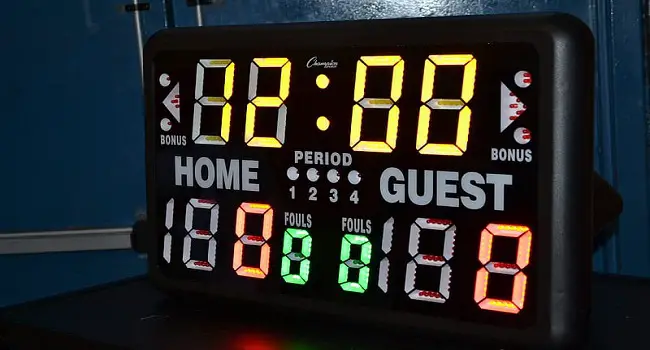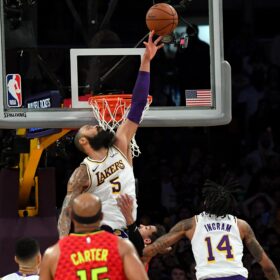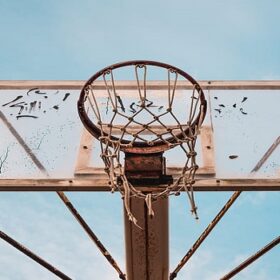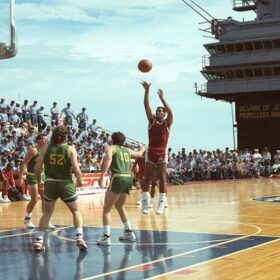Unlike soccer or football, the basketball players don’t have the liberty to roam around in the court and let the precious seconds go to waste. Once the ball is in your hands, you have to attempt to shoot a legal shot; successful or unsuccessful is on your luck. It is like a ticking time bomb that will go off any minute, and if you haven’t tried to shoot before time elapses, you will be called for a violation.
Sounds daunting yet exhilarating. A time limit and game are on the line; basketball players must feel like James Bond 007, who has a few seconds to save his country. So, consider the shot clock in basketball as a real game-saver. But don’t confuse it with the available timer clock. That records the duration of the game and in no way influences the dynamic of the game.
Shot Clock: The Basics
In layman’s terms, Shot Clock in Basketball is an instrument that is used to control and manage the tempo of the game and pace of the players. The defenders cannot wait around forever until the team musters up enough courage to take a chance at the basket. So, the shot clock counts down up to 24 seconds, in each possession, to make sure that after time elapses, either the possession of the ball is shifted between teams or a shot is taken in the given amount of time.
The shot clock is placed above both the hoops on either side so everyone can clearly view it. The players, the audience riveted to the edge of their seats, the coaches sweating profusely due to immense stress, and the management can track down the seconds left till the expiration of time.
With every passing second, the game becomes more interesting and more unpredictable. Will the offense shoot in time? Will the defenders tackle them and then shoot it before the shot clock expires? Or will the ball hit the hoop in a failed attempt of shooting, and the shot clock will continue to run?
Don’t worry! We will provide you answers to these all. But remember, it isn’t easy to rest the shot clock after every minor violation of inconvenience. There are only a few instances where it is started again:
- The other team gets a hold of the ball due to a change in possession that is incurred because of a violation; turnover or rebound.
- A team in possession of the ball tries to shoot the ball or the shot hits the rims and bounces back and is then rebounded to any of the teams.
- If any team commits a violation during the game or is charged with a foul and the referee blows his whistle to pause the game and indicate it, the clock resets.
- If a team is unable to shoot in the given time or shoots the ball and it fails to pass through the hoop, and it just touches the rim, the possession of the ball will be granted to the other team. The referee will point it out as the “delay of game”.
The Rule
The original rule in the NBA official rule book states that
“The ‘shot clock’ shall refer to the timing device that displays a countdown of the time within which the team possessing the ball must attempt a field goal. The shot clock shall start at 24 seconds unless otherwise provided in Rule 7. The shot clock shall be displayed in seconds, except tenths of seconds will also be displayed once the shot clock reaches 4.9 seconds.”
This shows the precision and accuracy that is taken into consideration to ensure that this violation is called upon rightly. The shot clock in basketball is more prone to occurring as it directly challenges the human fallibility.
History Of The Shot Clock In Basketball
You might wonder about the origin of this rule and how or why it was constituted. The legendary game of Fort Wayne Pistons and the Minneapolis Lakers is vastly recognized to date. It was a fine evening of 22 November 1950; these iconic players played the lowest scoring game in the history of the NBA. You won’t believe it, but the total number of points scored in the most crucial quarter, 4th, was 4 points. This added to an unbelievable collective score of 19-18.
This was not tolerable for NBA management. The league officials unanimously agreed to devise a way to increase the tempo and pace of the game. They didn’t want players to wander in the court, not taking the time restriction seriously. So, this is when the shot clock basketball idea emerged.
This action was a necessary step that had to be taken because many NBA fans had lost interest in the game because of watching incessantly low-scoring games. A change had to be introduced before the league lost all its fandom and collapsed.
Thigh the experimentation continued for four years before the league official could perfect the technique to control the pace of the players and accelerate it. In 1954 the successful trial of the 24-seconds shot clock was introduced by Syracuse Nationals owner Danny Biasone. But why 24 seconds? Doesn’t this seem like an awfully specific number? Let us see why:
“I looked at the box scores from the games I enjoyed, games where they didn’t screw around and stall. I noticed each team took about 60 shots. That meant 120 shots per game. So, I took 2,880 seconds (48 minutes) and divided that by 120 shots. The result was 24 seconds per shot.”
Comments made by Danny Biasone, Syracuse Nationals owner.
Thought the players were in disarray at the beginning, especially during the season of 1954-1955, as this was the first time that the players had to play under the growing time pressure. Their sole aim was to shoot as quickly as possible as they didn’t want to risk losing the possession of the ball.
But once the players learned the trick and optimally utilized their time, the average scores began to improve and soon went beyond the expectations. The players realized that it was important to expend adequate time to retain the possession and plan the perfect shoot.
The first game in which te shot clock was implemented was played among Rochester Royals and Boston Celtics, who were defeated by 98-95 life. These results were exceptional and boosted the attendance of the audience, which since the lowest scoring game in the NBA had wilted away.
Shot Clock For Different Basketball Leagues
NBA
The standard NBA shot clock in basketball has been set to 24 seconds for each possession. This staple rule has been implemented in the NBA basketball for as long as we can remember without being technically modified or altered. In decades of innovation in gameplay and the introduction of new and diligent strategies and legendry players, the shot clock basketball has remained a sole constant.
Though a slight variation was introduced to the rule, it states that if the offensive team has the possession of the ball and on their end of the court after a foul or a violation, the clock will be reset to 14 seconds. Due to this, you can witness over 100 possessions or more per game.
College
As the college level is the learning platform for the amateur players who are being prepared for the professional leagues, several versions of the shot clock were implemented at this level.
During the 1985-1986 season, a 45-second shot clock was made universal for all college leagues. At this time, NCAA was also making significant changes in its rules. Even the very next year, they established the 3-point shot.
NCAA didn’t see the results they had expected, and there was no major increase in the average scores, so they reduced the shot clock’s time duration to 35 seconds in the 1993-1994 season. This time frame remained untouched for two decades, but in the 2015-2016 session, it was changed to the standard 30 seconds.
Across The World
The shot clock has become widely popular and has been adopted by the FIBA and many other global leagues. This trend didn’t remain fortified just till basketball but is also implemented in other sports.
Examples Of Shot clock Violation In Basketball
If a team commits a shot clock violation, you will see an alert referee blowing the whistle, a red radiant light signaling, and a loud buzzer halting the game. This basketball violation results in the change in possession of the ball. If any of the following doesn’t happen when the given time elapses, a shot clock violation is called:
- The ball hasn’t touched the rim
- No basket has been shot, or no score has been achieved
- Change of possession isn’t made
If the clock hits zero, but the ball is not in the hands of the player but rather in the air on its way to the basket, it will not against any rule. But it should hit the rim at least.
Conclusion
You may list many reasons why basketball has garnered so much popularity; you would have probably reasoned it with the changing rules and regulations with the time. But among all the modifications and improvements, the only constant has made basketball so much entertaining and captivating for the past several decades. Just a shot clock in basketball and a few seconds counting down on it have changed the dynamics of the whole game and made it so much more exhilarating!






